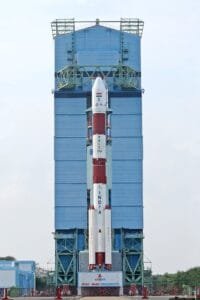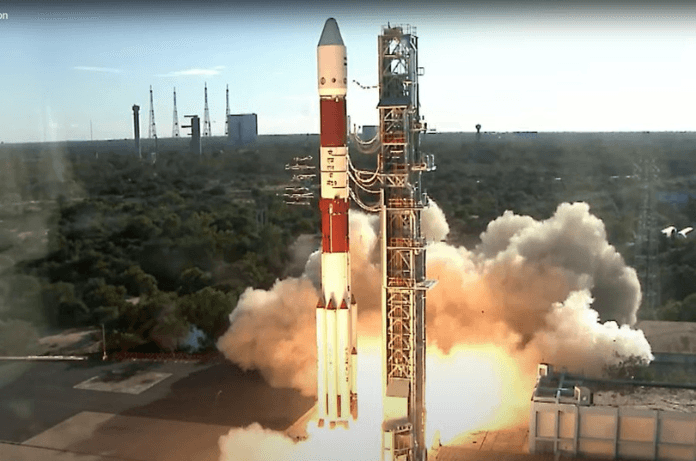The Indian Space Research Organisation (ISRO) has achieved another significant milestone by successfully launching the European Space Agency’s (ESA) Proba-3 mission. This groundbreaking mission, led by NewSpace India Limited (NSIL), was launched aboard the PSLV-C59 rocket from the Satish Dhawan Space Centre in Sriharikota, Andhra Pradesh.
This mission is particularly noteworthy as it introduces precision formation-flying technology, a global first, which will allow scientists to simulate a total solar eclipse and study the Sun’s corona in unprecedented detail.
The Successful PSLV-C59 Launch
In its 61st flight, the PSLV-C59 rocket placed the Proba-3 satellites into a highly elliptical orbit. This unique orbit spans 600 km at perigee (the closest point to Earth) and extends to 60,000 km at apogee (the farthest point), with an inclination of 59 degrees. ISRO Chairman Dr. S. Somanath announced the success, saying, “The PSLV-C59 Proba-3 mission is successfully accomplished. The spacecraft has been placed in the right orbit.”
This achievement highlights ISRO’s growing expertise in deploying advanced satellites and maintaining international collaborations with agencies like ESA.
Proba-3: Revolutionizing Space Technology
What is Proba-3?
Proba-3 is an In-Orbit Demonstration mission by the European Space Agency, designed to showcase the potential of precision formation flying. The mission comprises two small satellites:
- Coronagraph Spacecraft (310 kg)

Image: Liftoff of Proba3 on PSLV-XL rocket | Credit: X/ISRO - Occulter Spacecraft (240 kg)
These satellites will fly in precise formation, separated by 150 meters, to function as a single, rigid structure. Together, they will create a solar coronagraph, simulating the effect of a solar eclipse.
Why Study the Corona?
The Sun’s corona, with temperatures exceeding 2 million degrees Fahrenheit, plays a critical role in determining space weather, which impacts satellite operations and communications on Earth. By positioning one satellite to block the Sun’s light (Occulter) and the other to observe the corona (Coronagraph), Proba-3 allows scientists to extend corona observations to six hours a significant leap compared to the mere ten minutes during a natural solar eclipse.
This innovative setup enables detailed photography and study of the corona. This mission will uncover lesser-known features and behaviors that affect solar wind and magnetic fields.
A Feat in Formation-Flying Technology
Precision Formation Flying
The Proba-3 mission is the first in the world to showcase precision formation-flying capabilities at this scale. The two satellites will maintain a fixed formation, mimicking a rigid structure, to accurately replicate the solar eclipse phenomenon.
This technological breakthrough is a milestone in space rendezvous and formation-flying technologies, setting a precedent for future space missions that require multi-satellite coordination.
Orbital Details
The satellites will operate in a 19-hour orbit around Earth, gradually maneuvering to reach the solar rim for corona observations. The instruments on board take six hours per session to capture the solar corona.
A History of ISRO-ESA Collaboration
The Proba-3 mission marks the second ESA satellite launch aboard an Indian rocket. The first, Proba-1, was launched in 2001 using the PSLV and remains operational today, far exceeding its one-year mission life expectancy.
This enduring partnership underscores the global trust in ISRO’s capabilities and highlights the significance of international collaboration in advancing space exploration technologies.
Key Facts About Proba-3
- Two Satellites: The Coronagraph spacecraft (310 kg) and the Occulter spacecraft (240 kg) fly in precise formation, separated by 150 meters.
- Mission Objective: Study the Sun’s corona and provide critical insights into its role in space weather.
- Orbit Details: The mission involves a 19-hour orbit with instruments taking six hours to study the corona.
- PSLV Rocket: The 44.5-meter-tall rocket takes 18 minutes to deploy the satellites into their designated orbit.
What This Means for Space Science
The successful deployment of Proba-3 not only advances coronagraph technology but also opens new avenues for formation-flying missions. This achievement will likely inspire more collaborative projects between ISRO and other global space agencies.
By allowing longer and more detailed observations of the Sun’s outer atmosphere, Proba-3 promises to unlock valuable insights into the workings of our solar system and its effects on Earth.
ISRO Leads the Way
The PSLV-C59 mission is yet another feather in ISRO’s cap, demonstrating India’s ability to undertake sophisticated space missions. As Proba-3 progresses, it will not only enhance our understanding of the Sun but also pave the way for future innovations in space technology.
This mission highlights ISRO’s role as a global leader in space exploration and collaboration. With every successful launch, India continues to cement its position at the forefront of space innovation.

